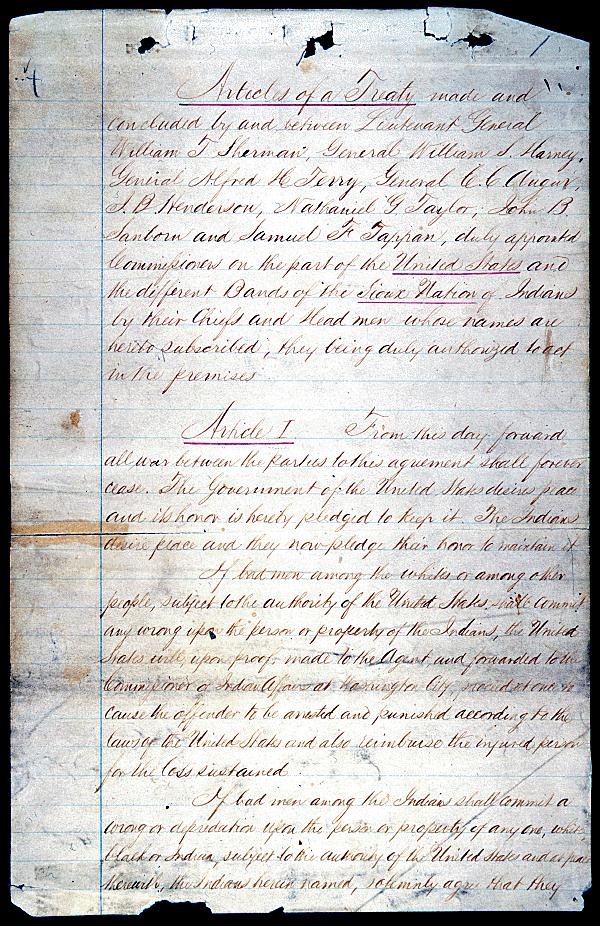
Wyoming
Reconstruction Vignette
Click image to make larger.
In 1868, federal officials met with members of the Sioux — Dakota, Lakota, and Nakota — and Arapaho bands in present-day Wyoming. They entered into the Treaty of Fort Laramie, establishing the Great Sioux Reservation and classifying the Black Hills in present-day South Dakota as “unceded Indian territory” to resettle and consolidate the Sioux. Pictured here is the first page of the agreement. This treaty was part of a larger campaign of increasingly powerful Republican elites and industrialists to expand the westward reach of U.S. sovereignty and capital through settler colonialism. They used broad Reconstruction-era discussions of U.S. reconciliation, citizenship, and racial inclusion to promote “civilization” and justify the seizure of Native land. The United States reneged on the Treaty of Fort Laramie in the 1870s, with the discovery of gold in the Black Hills.
Source: National Archives
Wyoming
Standards Overview
Coverage of Reconstruction: Nonexistent
ZEP Standards Rubric Score: 0 out of 10
The coverage of Reconstruction in Wyoming’s standards is nonexistent. The Wyoming Department of Education adopted its current Social Studies Content and Performance Standards in 2018. In 2017, Wyoming passed “Original House Bill 76/House Enrolled Act 119,” a law that required a review of the state social studies standards to ensure “that the heritage, history and contributions of American Indian tribes be addressed through education.” The standards adopted in 2018, thus, reflect a concerted effort to highlight Indigenous history, particularly that of the Indigenous Tribes of Wyoming.
At several points the standards require students to “analyze the historical development of the United States Constitution and treaties (e.g., 1868 Fort Bridger Treaty) and how they have shaped the United States and Wyoming Government (tribal, local, state, federal).” However, Reconstruction receives no mention and the Civil War is mentioned only once, in a middle school standard focused on understanding cause and effect in history.
The Wyoming Social Studies Standards are up for review again in 2023.
Because Wyoming’s standards provide so little information about whether and how districts and schools should teach Reconstruction, we chose to investigate curricula at the district level. The Local Snapshot below is not meant as a judgment of the district’s approach to Reconstruction. It was chosen largely at random and is not factored into the grade the state standards receive. The brief analysis of district-level curricula that follows is intended to simply provide a snapshot into how state standards, or lack thereof, can shape Reconstruction pedagogy in the classroom.
Local Snapshot
Laramie County School District 1 (Cheyenne)
Grade 8
Reconstruction is covered in grade 8. The “Curriculum Maps” for both the regular and Honors history courses set aside eight weeks for a unit on “Civil War and Reconstruction.” Coverage of Reconstruction itself is broad and generally focused on national political developments, though it does provide openings for teachers to delve more deeply into social and economic issues if they so choose.
Students are expected to know how Lincoln’s assassination affected Reconstruction, opposing approaches to Reconstruction, what “individuals and groups” were involved, and assess the “successes and limitations” of Reconstruction. The Honors course includes a requirement for students to “assess the extent to which key events of the Reconstruction Era represented progress toward, or setbacks from, full citizenship for African Americans.” The regular course does not include this learning goal.
Educator Experiences
A middle school teacher wrote in response to our survey that the state superintendent of education opposes truthful teaching of history. In May of 2021, Superintendent of Public Instruction Jillian Balow issued a statement decrying “critical race theory” as “an attempt to normalize teaching controversial and politically trendy theories about America’s history.” She has since supported the introduction of legislation in 2022 that will be designed to ban “critical race theory” from classrooms in Wyoming. However, the teacher who responded to our survey noted that the families of her students “understand that historical events are relevant to today.”
Assessment
Wyoming’s state standards on Reconstruction are nonexistent. The standards are broad but include several examples of “significant” historical moments and individuals — none of which cover Reconstruction. While districts may cover Reconstruction in their curricula, such as Laramie in grade 8, any mention of Reconstruction in Wyoming schools is technically optional.
Without guidance around key Reconstruction-era history, many students will not learn about the intensification of white supremacy, the Black Codes, the KKK, debates over who would control land and labor, and Black agency and political organizing. Teaching Reconstruction effectively requires centering Black people’s struggles to redefine freedom and equality and gain control of their own land and labor during and after the Civil War. Any discussion of Reconstruction must also grapple with the role of white supremacist terrorism in the defeat of Reconstruction and the negative and positive legacies of the era that persist to this day.
In 2022, Republican lawmakers introduced HB0097 and SF0103, two bills designed to prohibit schools from teaching about racism and sexism. Similar bills have been introduced in subsequent legislative sessions. None have passed, but their introduction is still troubling. Several respondents to our survey expressed concern about the possible chilling effects on classroom education that such bills can have around the country, particularly on discussions of the history and legacies of Reconstruction.